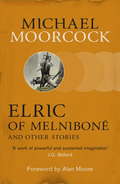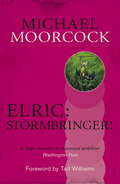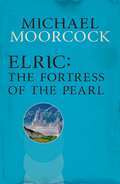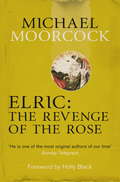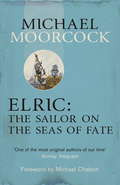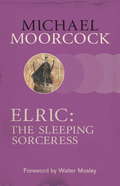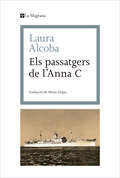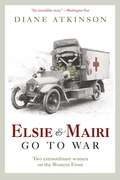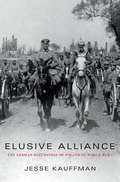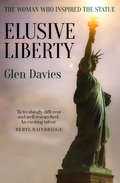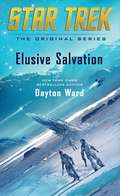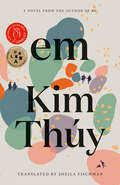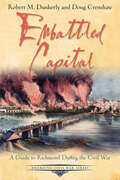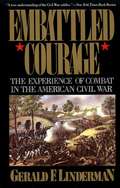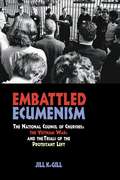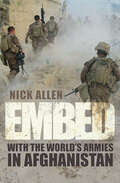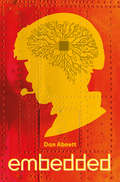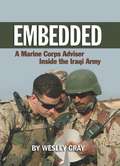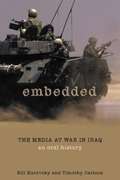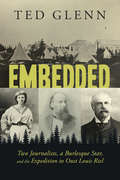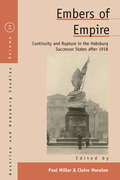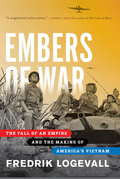- Table View
- List View
Elric of Melniboné and Other Stories
by Michael MoorcockGollancz is very proud to present the author's definitive editions of the saga of Elric, the last emperor of Melniboné. Michael Moorcock and his long-time friend and bibliographer John Davey have collaborated to produce the most consistent and coherent narrative from the disparate novels, novellas, short stories and non-fiction about Elric. From his early life in Melniboné all the way through to his final days, these seven volumes will be the definitive telling of the albino prince's story. Elric is one of the great creations of modern fantasy, and has inspired legions of imitators. If you know his story already, then this definitive edition will finally let you read the entire saga in the author's preferred order. If you've never experienced the chronicles of the albino with the soul-sucking sword, then this is the perfect place to start.
Elric: Stormbringer!
by Michael MoorcockFeared by enemies and friends alike, Elric of Melnibone walks a lonely path among the worlds of the multiverse. The destroyer of his own cruel and ancient race, as well as its final ruler, Elric is the bearer of a destiny as dark and cursed as the vampiric sword he carries - the sentient black blade known as Stormbringer.Containing the novel which perhaps did the most to propel Elric to the forefront of the fantasy genre, along with associated short stories and other material, this volume is a vital part of any fantasy reader's library. With an introduction by Tad Williams, this collection presents Moorcock's greatest creation in a revised and approved order.
Elric: The Fortress of the Pearl
by Michael MoorcockFeared by enemies and friends alike, Elric of Melnibone walks a lonely path among the worlds of the multiverse. The destroyer of his own cruel and ancient race, as well as its final ruler, Elric is the bearer of a destiny as dark and cursed as the vampiric sword he carries - the sentient black blade known as Stormbringer.With an introduction and a short story by Neil Gaiman, and containing complete novels as well as associated short stories, this collection presents Moorcock's greatest creation in a revised and approved order.
Elric: The Revenge of the Rose
by Michael MoorcockFeared by enemies and friends alike, Elric of Melnibone walks a lonely path among the worlds of the multiverse. The destroyer of his own cruel and ancient race, as well as its final ruler, Elric is the bearer of a destiny as dark and cursed as the vampiric sword he carries - the sentient black blade known as Stormbringer.The soul of Elric's father is tortured and suffering. To free it, Elric must face the princes of hell, and put all of his trust in one woman - the Rose.With an introduction by Holly Black, and containing THE REVENGE OF THE ROSE as well as associated short stories, this collection presents Moorcock's greatest creation in a revised and approved order.
Elric: The Sailor on the Seas of Fate
by Michael MoorcockGollancz is very proud to present the author's definitive editions of the saga of Elric, the last emperor of Melniboné. Michael Moorcock and his long-time friend and bibliographer John Davey have collaborated to produce the most consistent and coherent narrative from the disparate novels, novellas, short stories and non-fiction about Elric. From his early life in Melniboné all the way through to his final days, these seven volumes will be the definitive telling of the albino prince's story. Elric is one of the great creations of modern fantasy, and has inspired legions of imitators. If you know his story already, then this definitive edition will finally let you read the entire saga in the author's preferred order. If you've never experienced the chronicles of the albino with the soul-sucking sword, then this is the perfect place to start.Containing stories, novellas, supplementary material and commentary, these editions of Elric are the finest yet.
Elric: The Sleeping Sorceress
by Michael MoorcockGollancz is very proud to present the author's definitive editions of the saga of Elric, the last emperor of Melniboné. Michael Moorcock and his long-time friend and bibliographer John Davey have collaborated to produce the most consistent and coherent narrative from the disparate novels, novellas, short stories and non-fiction about Elric. From his early life in Melniboné all the way through to his final days, these seven volumes will be the definitive telling of the albino prince's story. Elric is one of the great creations of modern fantasy, and has inspired legions of imitators. If you know his story already, then this definitive edition will finally let you read the entire saga in the author's preferred order. If you've never experienced the chronicles of the albino with the soul-sucking sword, then this is the perfect place to start.Containing stories, novellas, supplementary material and commentary, these editions of ELRIC are the finest yet.
Els passatgers de l'Anna C.
by Laura AlcobaEls passatgers de l'Anna C. relata l'increïble viatge realitzat per un grapat de joves revolucionaris argentins a mitjans dels anys seixanta, amb la finalitat d’unir-se al Che Guevara. Estan preparats per donar la seva vida per la Revolució. L’any 1968 el vaixell Anna C. Portava en Manel i la Soledad de tornada a l’Argentina, després de dos anys d’entrenament guerriller a Cuba. Amb ells, hi havia la seva filla acabada de néixer. Llavors duia un altre nom, però és la mateixa Laura Alcoba, l’autora i narradora d’aquesta novel·la, que, passats els anys, ressegueix el periple dels seus pares i altres companys argentins, els quals, enduts per l’ideal revolucionari, van viatjar a Cuba per unir-se al Che i la revolució. Sota l’aspecte d’una investigació que duu a terme l’autora, preguntant als seus pares i als supervivents, i recreant brillantment l’experiència guerrillera dels protagonistes i l’ambient intel·lectual revolucionari, Els passatgers de l’Anna C. és una novel·la escrita amb tant de reconeixement com de distanciat i amable escepticisme, una novel·la feta de petits moments reveladors i escenes on conviuen les il·lusions invencibles de la joventut amb el trencament -pot ser inevitable- que experimenten els somnis en contacte amb la realitat.
Elsie and Mairi Go to War: Two Extraordinary Women on the Western Front
by Diane AtkinsonThe incredible story of two courageous and spirited women who were the only female participants to serve on the western front during World War I. When they met at a motorcycle club in 1912, Elsie Knocker was a thirty year-old motorcycling divorcee dressed in bottle-green Dunhill leathers, and Mairi Chisholm was a brilliant eighteen-year old mechanic, living at home borrowing tools from her brother. Little did they know, theirs was to become one of the most extraordinary stories of World War I. In 1914, they roared off to London 'to do their bit,' and within a month they were in the thick of things in Belgium driving ambulances to distant military hospitals. Frustrated by the number of men dying of shock in the back of their vehicles, they set up their own first-aid post on the front line in the village of Pervyse, near Ypres, risking their lives working under sniper fire and heavy bombardment for months at a time. As news of their courage and expertise spread, the 'Angels of Pervyse' became celebrities, visited by journalists and photographers as well as royals and VIPs. Glamorous and influential, they were having the time of their lives, and for four years Elsie and Mairi and stayed in Pervyse until they were nearly killed by arsenic gas in the spring of 1918. But returning home and adjusting to peacetime life--and the role of women in British society--was to prove more challenging than even the war itself.
Elsie's Troubled Times (Book Six of the Elsie Dinsmore: A Life of Faith Series)
by Martha Finley Mission City Press"But the newspapers say it cannot last long, Papa, three months at most," Elsie interjected. "The newspapers are wrong," Horace replied forcefully. "This is American against American, and neither side will be easily defeated," Edward said. Sadly, Horace added, "We must prepare ourselves to wait out a long and bitter conflict. When we next see our homeland, all will be changed forever." Elsie's life seems nearly perfect when she returns home from her honeymoon. But not even the true love of husband and family can shelter her from the great upheaval that lies ahead. They are soon caught up in the bitter struggles between North and South. When the nation is torn apart, how will Elsie and her loved ones deal with its tragedies? Who will survive? "Elsie's Troubled Times", the sixth book of the "Elsie Dinsmore: A Life of Faith" series, takes its heroine into one of the darkest periods of American history, the Civil War. As the war pits brother against brother on the battlefields, Elsie's ideals, loyalties, and even her Christian faith are threatened. "Elsie's Troubled Times", adapted from the 19th century novels written by Martha Finley, is a life-and-death story sure to grip the heart of every reader.
Elusive Alliance: The German Occupation of Poland in World War I
by Jesse KauffmanJesse Kauffman explains why Germany's ambitious attempt at nation-building in Poland during WWI failed. The educational and political institutions Germany built for its satellite state could not alleviate Poland's hostility to the plundering of its resources to fuel Germany's war effort.
Elusive Liberty: The Woman Who Inspired the Statue
by Glen DaviesThe woman immortalized as the Statue of Liberty comes to life in this “refreshingly different and well researched” novel of nineteenth century France (Beryl Bainbridge, author of The Dressmaker). France, 1867. The elite of the world have come to Paris for the Great Exhibition, where they can enjoy the sophistication of the French Empire of Napoleon III. At the Imperial court, young Jeanne-Emilie de Lamont meets the man who will change her life: Frederic Bartholdi, the Republican sculptor who finds in her the inspiration for his greatest creation. When France and Prussia go to war, Emilie’s world is thrown into turmoil. As Bismarck’s army surrounds Paris, she sees a side of the city—and of herself—she never before imagined. While Paris reels under the twin blows of war and revolution, Frederic’s hopes for his Statue of Liberty are under threat. It will take a new continent, and an old dream, to save it. But can he save the girl who was Liberty? A sweeping historical epic, Elusive Liberty takes the reader from the splendor of the Great Paris Exhibition to the Pyramids of Egypt, from the Franco-Prussian War to Philadelphia’s Centennial Exhibition in 1876. “An exciting talent.” —Beryl Bainbridge, author of Master Georgie
Elusive Salvation (Star Trek: The Original Series)
by Dayton WardAn all-new Star Trek adventure across time—the latest of the acclaimed Original Series novels!The Arctic Circle, 1845: Escaping the tyranny under which their people have lived for generations, aliens from a distant planet crash land on Earth’s inhospitable frozen wastes. Surviving the harsh conditions will pose a challenge, but over time the aliens will migrate to more populated areas, with decades passing as they work to conceal their presence from their former oppressors, who continue to hunt them at any cost. San Francisco, 2283: When a mysterious craft is detected entering the solar system, Admiral James Kirk is dispatched by Starfleet to confront the vessel. He meets with an emissary from the Iramahl, a previously unknown alien race who have come in search of their brothers and sisters thought to have gone missing in this area of space centuries earlier. Having recently thrown off the last chains of subjugation by another species, the Ptaen, they now believe their lost people hold the key to saving their entire race from eventual extinction. New York, 1970: Roberta Lincoln, young protégé of the mysterious agent Gary Seven, is shocked when she receives the oddest request for help—from the future… ™, ®, & © 2016 CBS Studios, Inc. STAR TREK and related marks are trademarks of CBS Studios, Inc. All Rights Reserved.
Elvis’s Army
by Brian Mcallister LinnWhen the Army drafted Elvis in 1958, it set about transforming the King of Rock and Roll from a rebellious teen idol into a clean-cut GI trained for nuclear warfare. Brian Linn traces the origins, evolution, and ultimate failure of the army's attempt to reinvent itself for the Atomic Age, and reveals the experiences of its forgotten soldiers.
Em
by Kim ThúyLONGLISTED FOR THE 2021 SCOTIABANK GILLER PRIZE Kim Thúy's Em is a virtuosic novel of profound power and sensitivity, and an enduring affirmation of the greatest act of resistance: love.In the midst of war, an ordinary miracle: an abandoned baby tenderly cared for by a young boy living on the streets of Saigon. The boy is Louis, the child of a long-gone American soldier. Louis calls the baby em Hồng, em meaning "little sister," or "beloved." Even though her cradle is nothing more than a cardboard box, em Hồng's life holds every possibility. Through the linked destinies of a family of characters, the novel takes its inspiration from historical events, including Operation Babylift, which evacuated thousands of biracial orphans from Saigon in April 1975, and the remarkable growth of the nail salon industry, dominated by Vietnamese expatriates all over the world. From the rubber plantations of Indochina to the massacre at My Lai, Kim Thúy sifts through the layers of pain and trauma in stories we thought we knew, revealing transcendent moments of grace, and the invincibility of the human spirit.
Emanuel, or Children of the Soil
by Henrik PontoppidanImmerse yourself in the profound and evocative world of rural Denmark with Henrik Pontoppidan's Emanuel, or Children of the Soil. This literary masterpiece, written by one of Denmark’s most celebrated authors and a Nobel Prize laureate, offers a compelling exploration of the human condition, societal struggles, and the timeless connection between people and the land they inhabit.Set against the backdrop of the Danish countryside, Emanuel, or Children of the Soil follows the life of Emanuel Hansted, a young idealist with a deep love for nature and a passion for social justice. Emanuel's journey is one of personal growth and disillusionment as he confronts the harsh realities of rural life and the complexities of human nature.Pontoppidan’s rich and nuanced narrative delves into the lives of the rural community, portraying their joys, sorrows, and enduring spirit with great empathy and detail. Through Emanuel's interactions with the villagers, Pontoppidan examines themes of tradition, progress, and the inevitable conflicts that arise when old ways meet new ideas.The novel is a vivid portrayal of the socio-economic changes occurring in late 19th-century Denmark, capturing the tensions between the agrarian past and the industrial future. Pontoppidan's exquisite prose brings the Danish landscape to life, painting a vivid picture of the fields, forests, and farms that shape the characters' lives and destinies.Emanuel, or Children of the Soil is more than just a story of one man's journey; it is a reflection on the broader human experience, exploring universal themes of hope, struggle, and the quest for meaning. Pontoppidan’s deep philosophical insights and his ability to convey the inner lives of his characters make this novel a timeless and thought-provoking read.
Embattled Capital: A Guide to Richmond During the Civil War (Emerging Civil War Series)
by Robert M. Dunkerly Doug CrenshawA guide to the former Confederate capital of Richmond, Virginia, with “a good deal of historical information, much of it neglected in histories of the war” (The NYMAS Review).“On To Richmond!” cried editors for the New York Tribune in the spring of 1861. Thereafter, that call became the rallying cry for the North’s eastern armies as they marched, maneuvered, and fought their way toward the capital of the Confederacy.Just 100 miles from Washington, DC, Richmond served as a symbol of the rebellion itself. It was home to the Confederate Congress, cabinet, president, and military leadership. And it housed not only the Confederate government but also some of the Confederacy’s most important industry and infrastructure. The city was filled with prisons, hospitals, factories, training camps, and government offices.Through four years of war, armies battled at its doorsteps—and even penetrated its defenses. Civilians felt the impact of war in many ways: food shortages, rising inflation, a bread riot, industrial accidents, and eventually, military occupation. To this day, the war’s legacy remains deeply written into the city and its history.This book tells the story of the Confederate capital before, during, and after the Civil War, and serves as a guidebook including a comprehensive list of places to visit: the battlefields around the city, museums, historic sites, monuments, cemeteries, historical preservation groups, and more.
Embattled Courage: The Experience of Combat in the American Civil War
by Gerald F. LindermanLinderman traces each soldier's path from the exhilaration of enlistment to the disillusionment of battle to postwar alienation. He provides a rare glimpse of the personal battle that raged within soldiers then and now.
Embattled Ecumenism: The National Council of Churches, the Vietnam War, and the Trials of the Protestant Left
by Jill K. GillThe Vietnam War and its polarizing era challenged, splintered, and changed The National Council of the Churches of Christ in the U. S. A. (NCC), which was motivated by its ecumenical Christian vision to oppose that war and unify people. The NCC's efforts on the war exposed its strengths and imploded its weaknesses in ways instructive for religious institutions that bring their faith into politics. Embattled Ecumenism explores the ecumenical vision, anti-Vietnam War efforts, and legacy of the NCC. Gill's monumental study serves as a window into the mainline Protestant manner of engaging political issues at a unique time of national crisis and religious transformation. In vibrant prose, Gill illuminates an ecumenical institution, vision, and movement that has been largely misrepresented by the religious right, dismissed by the secular left, misunderstood by laity, and ignored by scholars outside of ecumenical circles. At a time when the majority of scholarly work is committed to looking at the religious right, Gill's groundbreaking study of the Protestant Left is a welcome addition. Embattled Ecumenism will appeal to scholars of U. S. religion, politics, and culture, as well as historians of evangelicalism and general readers interested in U. S. history and religion.
Embed: To the End With the World's Armies in Afghanistan
by Nick AllenIn 2007, journalist Nick Allen quit a secure job in Pakistan as a news agency writer to experience the life of foreign troops fighting the Taliban in Afghanistan. Over several years he journeyed as an embedded reporter with a dozen armies, working his way through placid backwaters to remote, savage hotspots where daily clashes with insurgent forces were the norm.Driven by a desire to himself live and then convey some of the drama, tragedy, farce and sheer frustration experienced by soldiers and marines from California to Copenhagen, Allen returned again and again for ‘embeds’ with different contingents to explore a multinational effort that will surely define NATO’s future and events in South Asia, and the world, for many years to come. No other writer managed to gain such broad access to the forty-two-country Coalition that was deployed in Afghanistan, or produce an account that carries so much of the essence of soldiering in this inhospitable environment, where extremes of climate, treachery and enemy cunning have always defeated nations that dared to wage war in the ‘graveyard of empires.’Embed explores the fragile calm of Bamiyan and its ancient sites and other low-intensity regions – usually ignored but a vital part of the overall picture – together with the ferocious clashes of Helmand, Kandahar, Kunar and other provinces. The author found that even the most sophisticated armed forces had been sucked into a fight they were ill-prepared for and, amid political uncertainty and dwindling public support back home, ultimately could not win.
Embedded
by Dan AbnettHE'D DO ANYTHING TO GET A STORY. When journalist Lex Falk gets himself chipped into the brain of a combat soldier, he thinks he has the ultimate scoop - a report from the forbidden front line of a distant planetary war, live to the living rooms of Earth. When the soldier is killed, however, Lex has to take over the body and somehow get himself back to safety once more... broadcasting all the way.Heart-stopping combat science fiction from the million-selling Warhammer 40,000 author.File Under: Science Fiction [ Future Warefare | Chipped-In | Anything For a Story | Get Out Alive! ]From the Paperback edition.
Embedded
by Wesley R. GrayIn 2006, 1st Lt. Wesley Gray was deployed as a U.S. Marine Corps military adviser to an Iraqi Army battalion in the Haditha Triad. For 210 days, he lived and fought beside Iraqi soldiers in the most dangerous and austere province of western Iraq. Al-Anbar was filled with an insurgent population traumatized by a recent massacre of twenty-four men, women, and children shot at close range by U.S. Marines in retaliation for the death of one of their comrades in a roadside bombing. Despite the high tensions created by the shootings, Gray was able to form a bond with the Iraqis because he had an edge that very few U.S. service members possess -the ability to communicate in Iraqi Arabic. His language skills and his understanding of the culture led the Iraqi soldiers to call him a brother and fondly name him Jamal. By the end of his tour he was a legend within the Iraqi Army. Gray draws on the brutally honest and detailed record he kept during his tour, including extensive interviews with Iraqi soldiers and citizens. He offers a comprehensive portrait of the struggles of the Iraqi people to make their country a nation once again and includes a compelling report on the status and prospects of the U.S. government's strategy for success in Iraq.
Embedded: The Media At War in Iraq
by Bill Katovsky Timothy Carlson<P>EMBEDDED is a collection of deeply emotional and highly personal accounts of covering the Iraq War. Many of the world's top war correspondents and photographers speak candidly about life on the battlefield. Here are articulate and heartfelt descriptions of fear and firefights, of bullets and banalities, of risking death and meeting deadlines. <P>With over sixty interviews conducted in Kuwait and Iraq shortly after many returned home, Katovsky and Carlson allowed these journalists to step outside their professional role as journalists and examine the lethal allure of combat reporting. <P>Here is CBS Evening News correspondent Jim Axelrod discussing the perils of racing to Baghdad while despondent over the death of a television colleague and being unexpectedly comforted by ABC News Nightline's Ted Koppel; Newsweek reporter Scott Johnson unwittingly driving into an ambush and then kicking out the windshield of his bullet-riddled car to escape the Iraqi gunmen; New York Times Baghdad Bureau Chief John Burns's brave refusal to be intimidated by his Iraqi information ministry minders; and many, many more. <P>Each interview in EMBEDDED maps its own personal path and narrative arc, while presenting an emotional window to war and reporting. Taken individually, each offers a unique view of the most-covered war in history. Collectively, EMBEDDED is an eyewitness to history that will do for the war in Iraq what Michael Herr's Dispatches did for Vietnam.
Embedded: Two Journalists, a Burlesque Star, and the Expedition to Oust Louis Riel
by Ted GlennA first-hand chronicle of Wolseley’s expedition to end Riel’s Red River Rebellion by a remarkable trio embedded on the mission. In the spring of 1870, two reporters set off from Toronto to cover one of the biggest stories in Canadian history: Colonel Garnet Wolseley’s 1870 expedition to Red River. Over the course of six months, the Daily Telegraph’s Robert Cunningham and the Globe’s Molyneux St. John brought readers along as they paddled and portaged alongside the expedition’s 1,100 troops and 400 voyageurs and guides from the shores of Lake Superior to Fort Garry.But that’s not the whole story. Buried well below the fold was the fact that St. John’s wife — international burlesque star Kate Ranoe — accompanied him and the expedition, and not just as an adventurer. Owing to an accident early on, Ranoe ended up ghostwriting many of St. John’s stories. Embedded is the remarkable story of two reporters and one extraordinary woman as they journeyed to Red River with Colonel Garnet Wolseley and his expeditionary force.
Embers of Empire: Continuity and Rupture in the Habsburg Successor States after 1918 (Austrian and Habsburg Studies #22)
by Paul Miller Claire MorelonThe collapse of the Habsburg Monarchy at the end of World War I ushered in a period of radical change for East-Central European political structures and national identities. Yet this transformed landscape inevitably still bore the traces of its imperial past. Breaking with traditional histories that take 1918 as a strict line of demarcation, this collection focuses on the complexities that attended the transition from the Habsburg Empire to its successor states. In so doing, it produces new and more nuanced insights into the persistence and effectiveness of imperial institutions, as well as the sources of instability in the newly formed nation-states.
Embers of War: The Fall of an Empire and the Making of America's Vietnam
by Fredrik LogevallThe struggle for Vietnam occupies a central place in the history of the twentieth century. Fought over a period of three decades, the conflict drew in all the world's powers and saw two of them--first France, then the United States--attempt to subdue the revolutionary Vietnamese forces. For France, the defeat marked the effective end of her colonial empire, while for America the war left a gaping wound in the body politic that remains open to this day. How did it happen? Tapping into newly accessible diplomatic archives in several nations and making full use of the published literature, distinguished scholar Fredrik Logevall traces the path that led two Western nations to lose their way in Vietnam. Embers of War opens in 1919 at the Versailles Peace Conference, where a young Ho Chi Minh tries to deliver a petition for Vietnamese independence to President Woodrow Wilson. It concludes in 1959, with a Viet Cong ambush on an outpost outside Saigon and the deaths of two American officers whose names would be the first to be carved into the black granite of the Vietnam Veterans Memorial. In between come years of political, military, and diplomatic maneuvering and miscalculation, as leaders on all sides embark on a series of stumbles that makes an eminently avoidable struggle a bloody and interminable reality. Logevall takes us inside the councils of war--and gives us a seat at the conference tables where peace talks founder. He brings to life the bloodiest battles of France's final years in Indochina--and shows how from an early point, a succession of American leaders made disastrous policy choices that put America on its own collision course with history: Harry Truman's fateful decision to reverse Franklin Delano Roosevelt's policy and acknowledge France's right to return to Indochina after World War II; Dwight Eisenhower's strenuous efforts to keep Paris in the fight and his escalation of U.S. involvement in the aftermath of the humiliating French defeat at Dien Bien Phu; and the curious turnaround in Senator John F. Kennedy's thinking that would lead him as president to expand that commitment, despite his publicly stated misgivings about Western intervention in Southeast Asia. An epic story of wasted opportunities and tragic miscalculations, featuring an extraordinary cast of larger-than-life characters, Embers of War delves deep into the historical record to provide hard answers to the unanswered questions surrounding the demise of one Western power in Vietnam and the arrival of another. This book will become the definitive chronicle of the struggle's origins for years to come.Advance praise for Embers of War "Fredrik Logevall has gleaned from American, French, and Vietnamese sources a splendid account of France's nine-year war in Indochina and the story of how the American statesmen of the period allowed this country to be drawn into the quagmire."--Neil Sheehan, author of A Bright Shining Lie, winner of the Pulitzer Prize and the National Book Award "Fredrik Logevall is a wonderful writer and historian. In his new book on the origins of the American war in Vietnam, he gives a fascinating and dramatic account of the French war and its aftermath, from the perspectives of the French, the Vietnamese, and the Americans. Using previously untapped sources and a deep knowledge of diplomatic history, Logevall shows to devastating effect how America found itself on the road to Vietnam."--Frances FitzGerald, author of Fire in the Lake, winner of the Pulitzer Prize and the National Book Award
